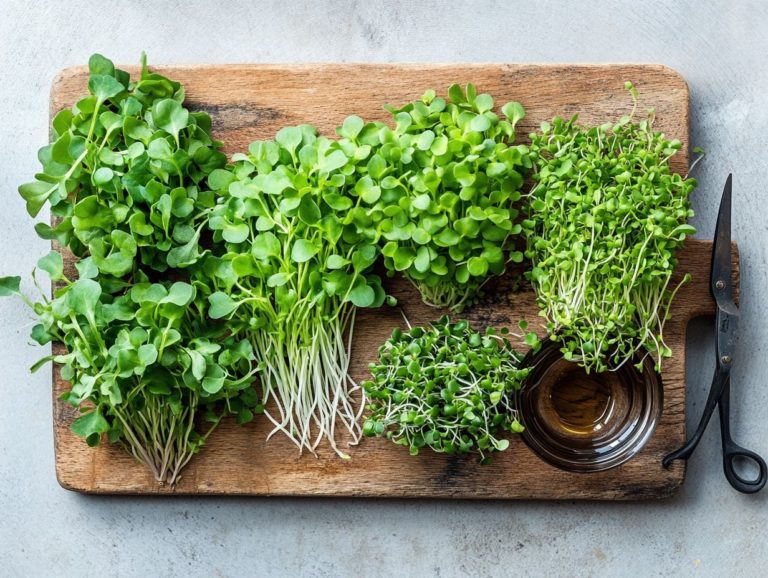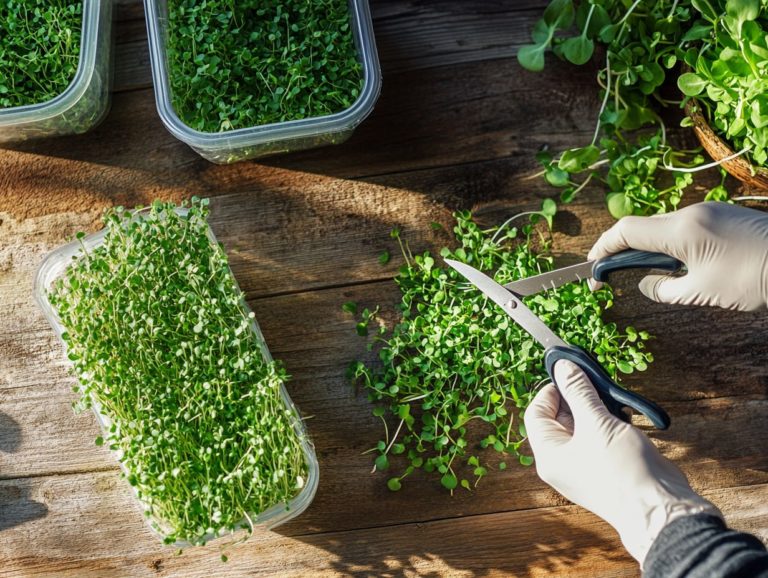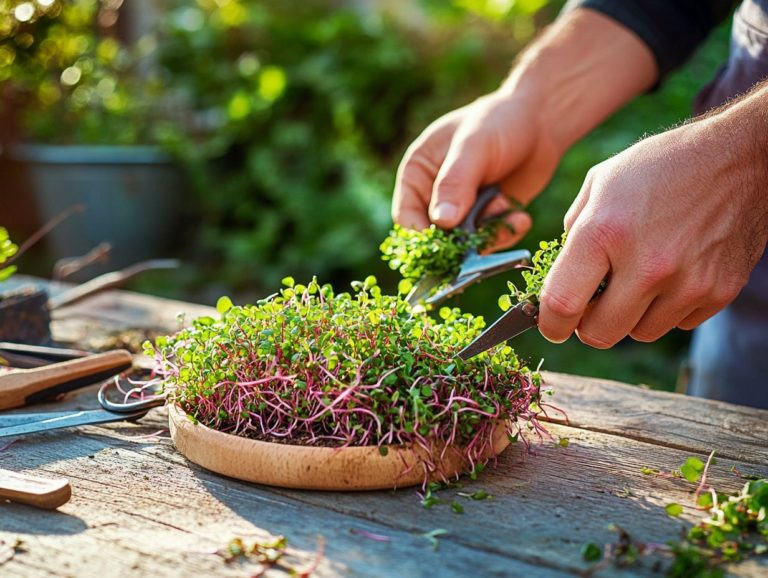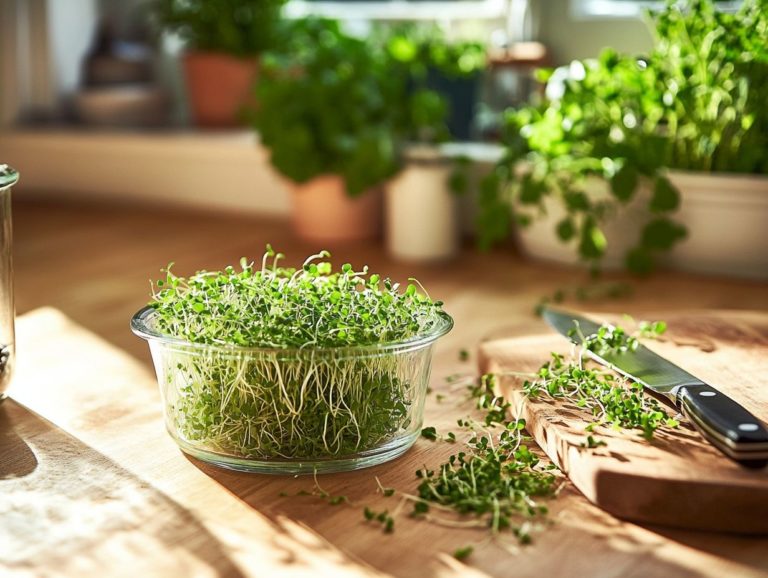5 Key Factors for Successful Microgreen Storage
Microgreens have truly captivated the culinary landscape, delivering vibrant flavors and a wealth of nutrients in minuscule packages. It’s essential to prioritize storage to enjoy your microgreens longer!
This guide unveils five essential factors to keep your microgreens fresh and bursting with flavor. From optimal harvesting techniques to ideal temperature conditions and efficient packaging methods, you’ll find all the insights you need to maximize their longevity.
Explore the nuances of microgreen storage and elevate your culinary creations to new heights!
Contents
- Key Takeaways:
- 1. Proper Harvesting Techniques
- 2. Appropriate Storage Containers
- 3. Ideal Temperature and Humidity Levels
- 4. Regular Inspection and Maintenance
- 5. Efficient Packaging and Labeling
- What Are Microgreens and Why Are They Popular?
- What Are the Different Types of Microgreens?
- How Do You Know When Microgreens Are Ready to Be Harvested?
- What Are the Best Storage Containers for Microgreens?
- How Can Temperature and Humidity Affect Microgreen Storage?
- What Are the Common Issues to Watch Out for When Storing Microgreens?
- What Are the Best Practices for Packaging and Labeling Microgreens?
- Microgreens Storage Duration
- What Are Some Creative Ways to Use Stored Microgreens?
- How Can Proper Microgreen Storage Help with Business Success?
- Frequently Asked Questions
- What are the five key factors for successful microgreen storage?
- How does temperature affect microgreen storage?
- Why is humidity important for microgreen storage?
- How does air circulation impact microgreen storage?
- Why is cleanliness crucial for successful microgreen storage?
- What is the importance of proper packaging for microgreen storage?
Key Takeaways:
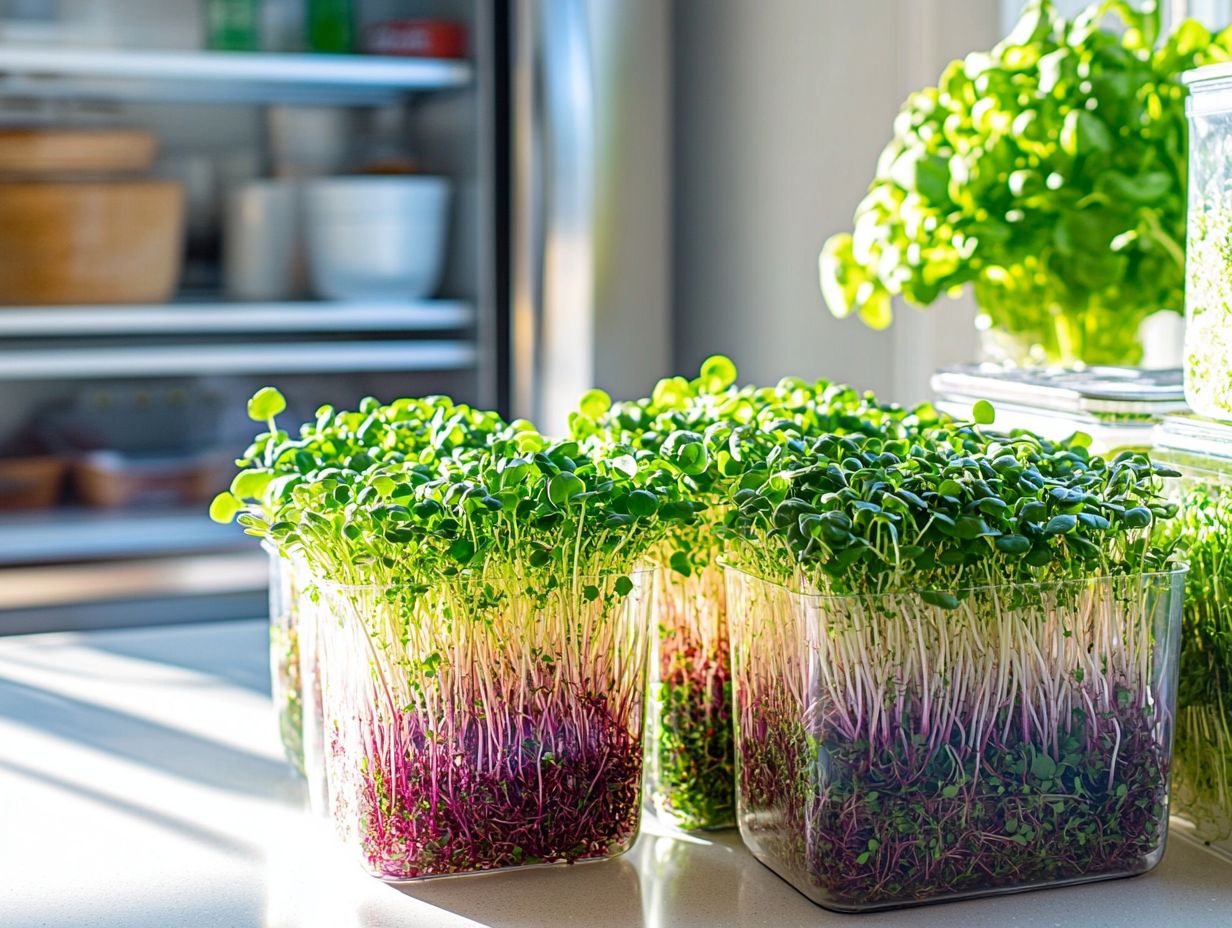
- Proper harvesting techniques ensure the best quality and longer shelf life for microgreens.
- Using appropriate storage containers maintains freshness and prevents contamination.
- Maintaining ideal temperature and humidity levels extends the shelf life of microgreens while preserving their flavor and nutritional value.
1. Proper Harvesting Techniques
Proper harvesting techniques are essential for ensuring the quality and longevity of your microgreens. They directly influence freshness, flavor retention, and nutritional value, making it imperative to master these methods for optimal results.
To start, wield a sharp knife or scissors for a clean cut that minimizes damage to delicate stems. Gentle handling is key; even a slight bruise during harvest can compromise overall quality.
Timing is crucial harvesting when your microgreens reach about two to three inches in height typically yields the best flavor and moisture levels. For varieties like radish and broccoli, aim to cut just above the soil line to preserve their vibrant color and crisp texture.
These little details not only elevate the taste but also enhance the visual appeal on the plate, allowing you to create an impressive presentation for any meal.
2. Appropriate Storage Containers
Choosing the right storage containers is essential for maintaining the freshness and shelf life of your microgreens. Proper containers are crucial for regulating moisture levels and airflow, effectively preventing flavor deterioration caused by natural gases released by fruits, which can spoil other produce.
Opting for plastic containers with ventilation holes is a smart move, as these allow for proper air circulation while keeping excess moisture at bay. Striking this balance is critical; too much moisture can lead to condensation, affecting the texture of your microgreens and encouraging mold growth.
Utilizing breathable materials ensures that your greens remain crisp and vibrant. It’s also important to regularly check the humidity levels inside the containers to keep them at an optimal range for storing microgreens. By managing these factors carefully, you can extend their freshness and savor their unique flavors and nutritional benefits for longer.
3. Ideal Temperature and Humidity Levels
Maintaining the perfect temperature and humidity levels is vital for storing microgreens, as these elements dramatically affect their freshness, crispness, and overall quality especially when using refrigerator storage.
Microgreens generally thrive within a temperature range of 32 F to 40 F, alongside humidity levels of around 50-60%. It s essential to steer clear of excessive moisture, which can lead to mold and spoilage.
To keep an eye on these conditions, consider investing in a small hygrometer a device that measures humidity and a thermometer to monitor your storage environment. Placing a paper towel in the container can help absorb any excess moisture, striking a balance that keeps the microgreens in top shape.
By regularly checking on your greens, you ll be able to catch any fluctuations early, ensuring their vibrant qualities remain intact.
Start storing your microgreens the right way today, and enjoy their fresh flavors longer!
4. Regular Inspection and Maintenance
Regular inspection and maintenance are essential practices for your microgreen storage. They ensure that freshness and flavor are preserved while keeping an eye out for potential issues like moisture imbalance or spoilage.
These checks keep your microgreens looking fresh and vibrant! It’s crucial to check the moisture; the ideal environment should be neither too dry nor overly damp. A handy tip is to feel the soil; it should be slightly moist but not saturated. Watch for any discoloration or wilting leaves, as these can signal aging or disease.
Rotating your containers improves air circulation, further protecting the quality of your microgreens. By implementing these strategies, you can cultivate a thriving microgreen garden brimming with robust flavors and nutrients.
5. Efficient Packaging and Labeling
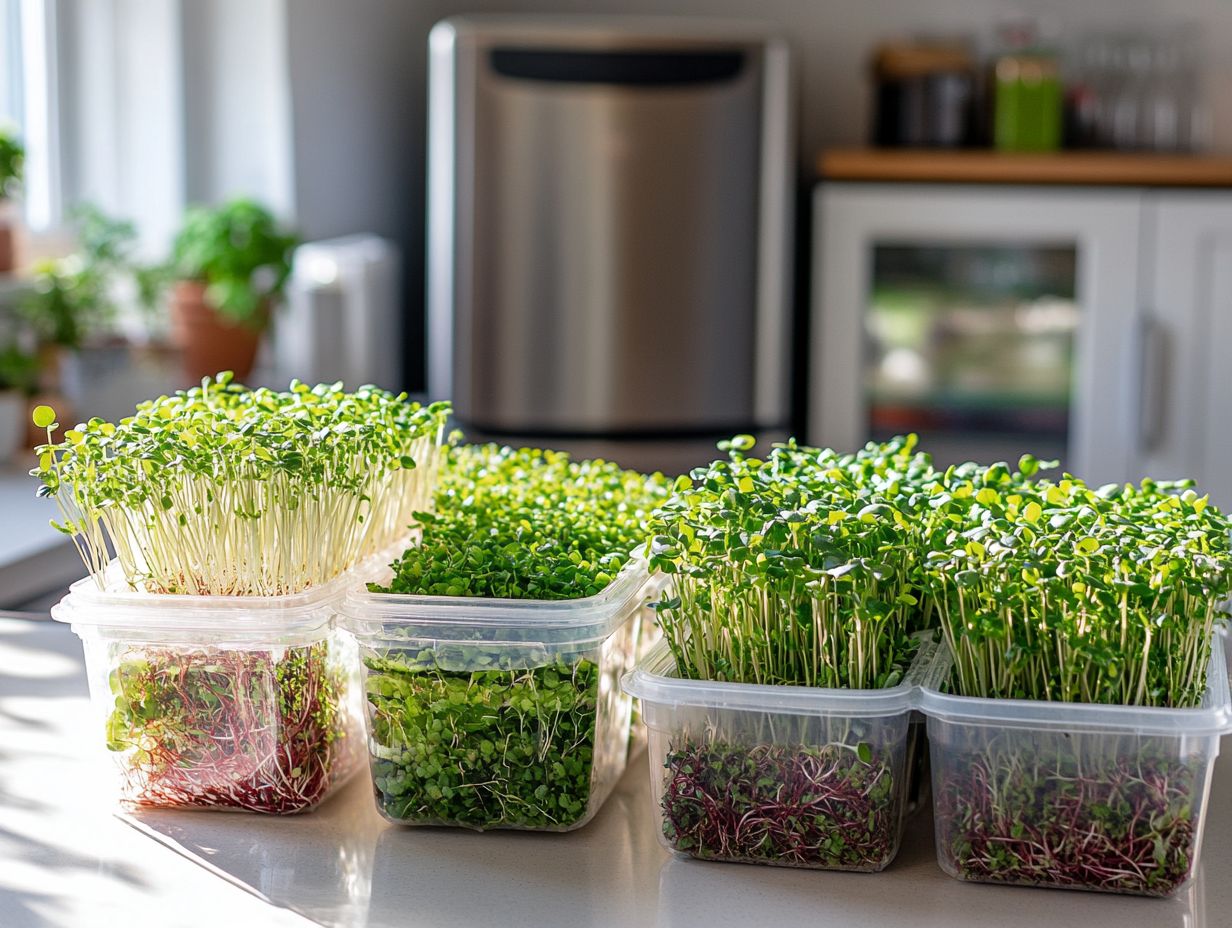
Efficient packaging and labeling of microgreens not only helps you stay organized but also enhances your storage techniques. This approach allows for better tracking of freshness and shelf life, making it a must-do for home gardening enthusiasts.
Using airtight containers or biodegradable bags can significantly extend the lifespan of your freshly harvested greens while retaining their vibrant flavors. For more tips on storage, clear labeling is essential; each container should indicate the variety of microgreens and the date of harvest, ensuring you make the most of them. To learn more about this process, check out how to prevent spoilage in microgreens.
If you’re eager to refine your skills, a wealth of video tutorials is available to guide you in the best methods for packaging and labeling effectively. These resources also provide excellent kitchen tips on how to store microgreens in your refrigerator, helping you maintain their crisp texture and nutrient density for extended periods.
What Are Microgreens and Why Are They Popular?
Microgreens have surged in popularity lately, and it s no wonder they pack an impressive nutritional punch and tantalizing flavors. They are a breeze to grow in your home garden, making them a hit with both food lovers and health-conscious individuals.
These petite, edible wonders are typically harvested just after their first true leaves make an appearance, offering a concentrated source of vitamins, minerals, and antioxidants. Remarkably, they often contain higher nutrient levels than their fully-grown counterparts. You can cultivate them in various media, whether it s soil, coconut coir, or even hydroponically. They flourish indoors with minimal space and light, making them accessible to everyone, regardless of gardening expertise.
Their versatility in the kitchen is truly something to behold! You can toss them into salads, layer them on sandwiches, blend them into smoothies, or use them as garnishes. Not only do they elevate the nutritional value of your dishes, but they also introduce vibrant color and texture. The rising trend of urban farming and a heightened awareness of health have undeniably fueled interest in these miniature greens, making their way into both home kitchens and restaurant menus.
What Are the Different Types of Microgreens?
You ll discover a remarkable variety of microgreens, such as radish, broccoli, mustard, arugula, and basil, each with unique flavors and nutritional profiles that enhance a multitude of culinary creations.
These tiny greens not only add vibrant colors and delightful textures to your plates but also come packed with an impressive array of health benefits. For example, radish microgreens deliver a peppery punch, making them ideal for livening up salads and sandwiches. On the other hand, broccoli microgreens offer a milder, slightly sweet flavor that pairs beautifully in stir-fries and smoothies.
Mustard microgreens bring a delightful zing to any dish, serving as an excellent garnish or a flavorful addition to savory meals. When selecting which varieties to grow, consider your taste preferences if you lean towards the spicier side, radish or mustard will be your best bet. Those who prefer milder flavors may find themselves drawn to basil or broccoli.
How Do You Know When Microgreens Are Ready to Be Harvested?
Knowing when your microgreens are ready for harvest is essential to maximizing their freshness and flavor. You can typically gauge this by observing their size, color, and overall health during germination.
To capture peak flavor and nutritional value, keep an eye on those delicate leaves. They should look vibrant and crisp, indicating their nutritional potency. Aim for a height of about one to three inches for most varieties; this tells you they re young yet fully developed. The first leaves that appear on the plant should be bright and robust, free from any signs of wilting or discoloration.
Harvest your microgreens just before they start to lose their vibrant flavors to enjoy their best taste and nutritional punch! This guarantees a delightful flavor and preserves the rich vitamins and minerals that make microgreens a coveted addition to your dishes.
What Are the Best Storage Containers for Microgreens?
Selecting the best storage containers for your microgreens is crucial for keeping them fresh. Consider options like plastic containers designed to regulate moisture levels and ensure proper airflow.
Glass jars or breathable cloth bags can also work wonders in creating a healthy environment for these delicate plants. Each type of container offers unique benefits, such as stability and visibility, making it easier for you to monitor the condition of your home microgreens. For optimal freshness, consider storing microgreens in the refrigerator using best practices.
Proper air circulation prevents mold growth and extends their shelf life, ensuring they stay vibrant and nutritious. By prioritizing containers that offer both moisture control and sufficient ventilation, you can relish your microgreens for a longer duration, maximizing their freshness and nutritional value, as detailed in our guide on how to store microgreens for maximum freshness.
How Can Temperature and Humidity Affect Microgreen Storage?
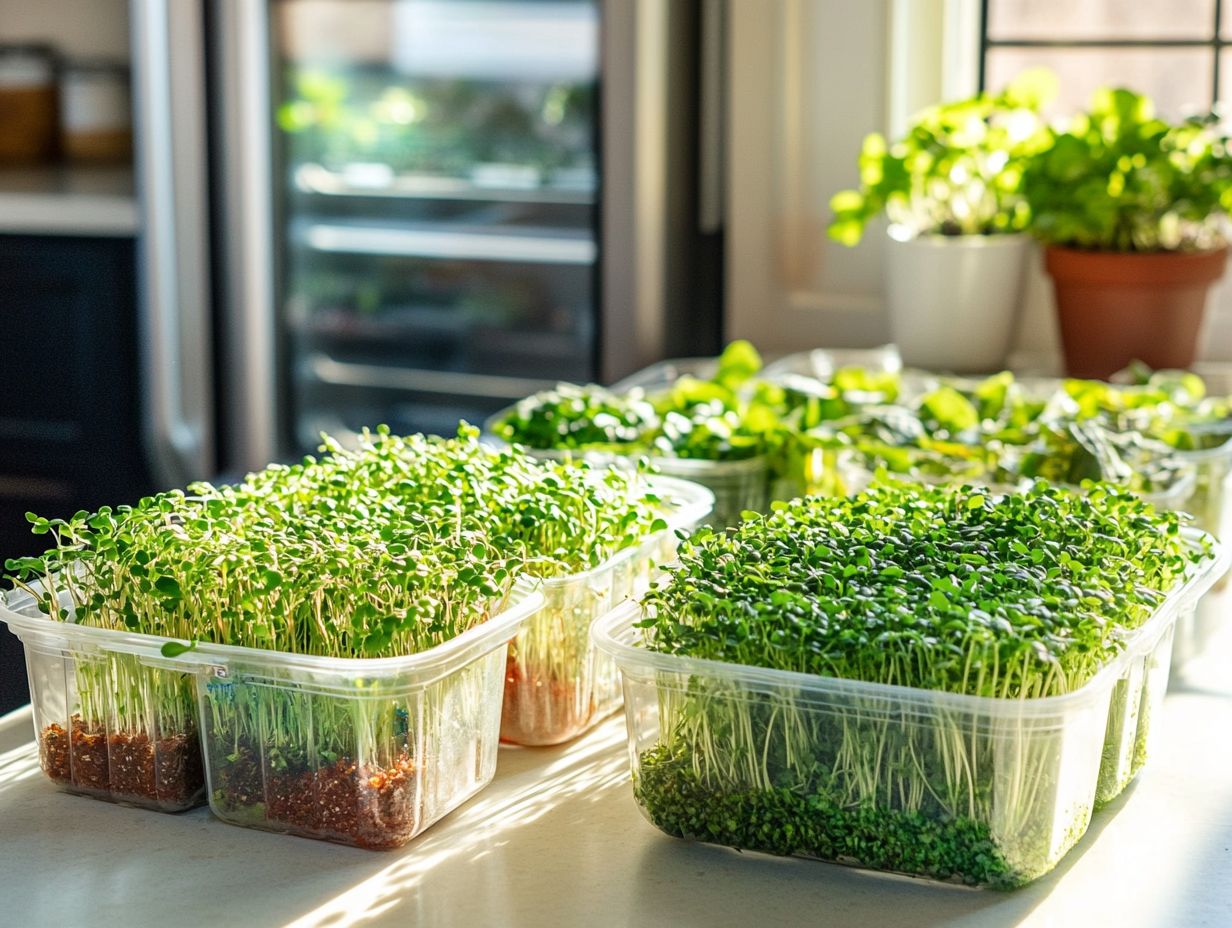
Temperature and humidity are crucial when it comes to storing your microgreens. If the conditions aren’t just right, you might find moisture building up, which can lead to a loss of crispness and flavor, ultimately compromising their quality.
To keep them at their best, aim for an ideal temperature typically between 34 and 38 degrees Fahrenheit, with humidity levels around 65% to 75%. For example, leafy varieties like arugula flourish in cooler conditions, while others, such as basil, prefer a slightly warmer atmosphere to maintain their vibrant flavors.
To create the perfect conditions, consider utilizing a refrigerator equipped with a hygrometer and an ice pack to help regulate humidity levels around your microgreens. Opt for breathable containers to prevent excess moisture from building up, ensuring your microgreens stay crisp and full of flavor for a longer period. For more detailed information, check out this guide on how to store different microgreen varieties.
What Are the Common Issues to Watch Out for When Storing Microgreens?
When storing microgreens, you might encounter several common issues, such as moisture imbalance, condensation, and subsequent flavor deterioration, all of which can compromise their freshness and overall quality.
Addressing these challenges proactively is essential to ensure your greens retain their vibrant taste and crispness. One effective strategy is to keep a close eye on moisture levels; excessive humidity can invite mold and decay, while insufficient moisture can lead to wilting. Additionally, learning how to extend the shelf life of microgreens can further help maintain their quality.
Maintaining an optimal temperature range is also crucial to prevent the growth of bacteria and unwanted condensation. By implementing straightforward storage techniques, like using airtight containers or humidity control packs, you can effectively manage these conditions and significantly enhance the longevity of your microgreens.
Key Takeaway: Keep your microgreens fresh and flavorful by monitoring temperature and humidity, and use proper storage techniques!
Call to Action: Ready to enjoy the amazing flavors of homegrown microgreens? Start growing and storing your own today!
What Are the Best Practices for Packaging and Labeling Microgreens?
Implementing best practices for packaging and labeling microgreens is essential for maintaining organization and ensuring best storage practices for fresh microgreens. This aids in tracking freshness and enhances the overall quality of your greens.
To preserve the vibrant flavors and nutrients of these delicate greens, consider using breathable containers. This choice improves air flow, prevents moisture buildup, and safeguards them from physical damage.
Clear labeling is crucial. Using waterproof markers or printed labels that include harvesting dates and variety names will make identification straightforward.
If you’re a home cook eager to optimize your microgreen usage, a wealth of friendly video tutorials is available online. These guides offer step-by-step instructions on efficient storage methods and preparation techniques in the kitchen, providing practical insights to enjoy microgreens at their freshest.
Microgreens Storage Duration
The shelf life of microgreens can fluctuate based on their variety and storage conditions. With the right handling, you can extend their freshness and flavor retention for several days to a week.
Recognizing that certain microgreens varieties, like pea shoots, tend to outlast more delicate greens such as arugula can assist in meal planning. Factors like moisture levels, light exposure, and temperature play vital roles in their durability. Moreover, knowing tips for washing and storing microgreens can help maintain their freshness.
For instance, if you store microgreens in a cool, dark place preferably wrapped in a damp paper towel within a sealed container, you can significantly slow down wilting and spoilage by gently handling them. Additionally, following 5 tips for successful microgreen germination can help enhance their freshness and longevity.
Rinsing and ensuring they are thoroughly dried before storage helps prevent excess moisture, which can hasten decay. By following the best practices for indoor microgreens, you can savor the vibrant taste and health benefits of fresh microgreens for an extended period.
What Are Some Creative Ways to Use Stored Microgreens?
Stored microgreens offer a canvas of creative possibilities, enhancing dishes with their vibrant colors, unique textures, and rich flavors, while ensuring that taste remains intact.
Imagine transforming a simple salad into a delightful explosion of taste and visual appeal with these nutrient-packed greens, such as radish microgreens. Picture radish microgreens delivering a peppery kick to a classic Caesar or incorporating pea shoots into a refreshing summer salad with strawberries and feta.
In sandwiches, a handful of sunflower microgreens not only provides a satisfying crunch but also adds a burst of freshness that complements favorite spreads beautifully. These greens excel as stunning garnishes, effortlessly elevating the presentation of soups, entrees, and even cocktails, turning every meal into a culinary masterpiece while demonstrating effective preservation techniques.
How Can Proper Microgreen Storage Help with Business Success?
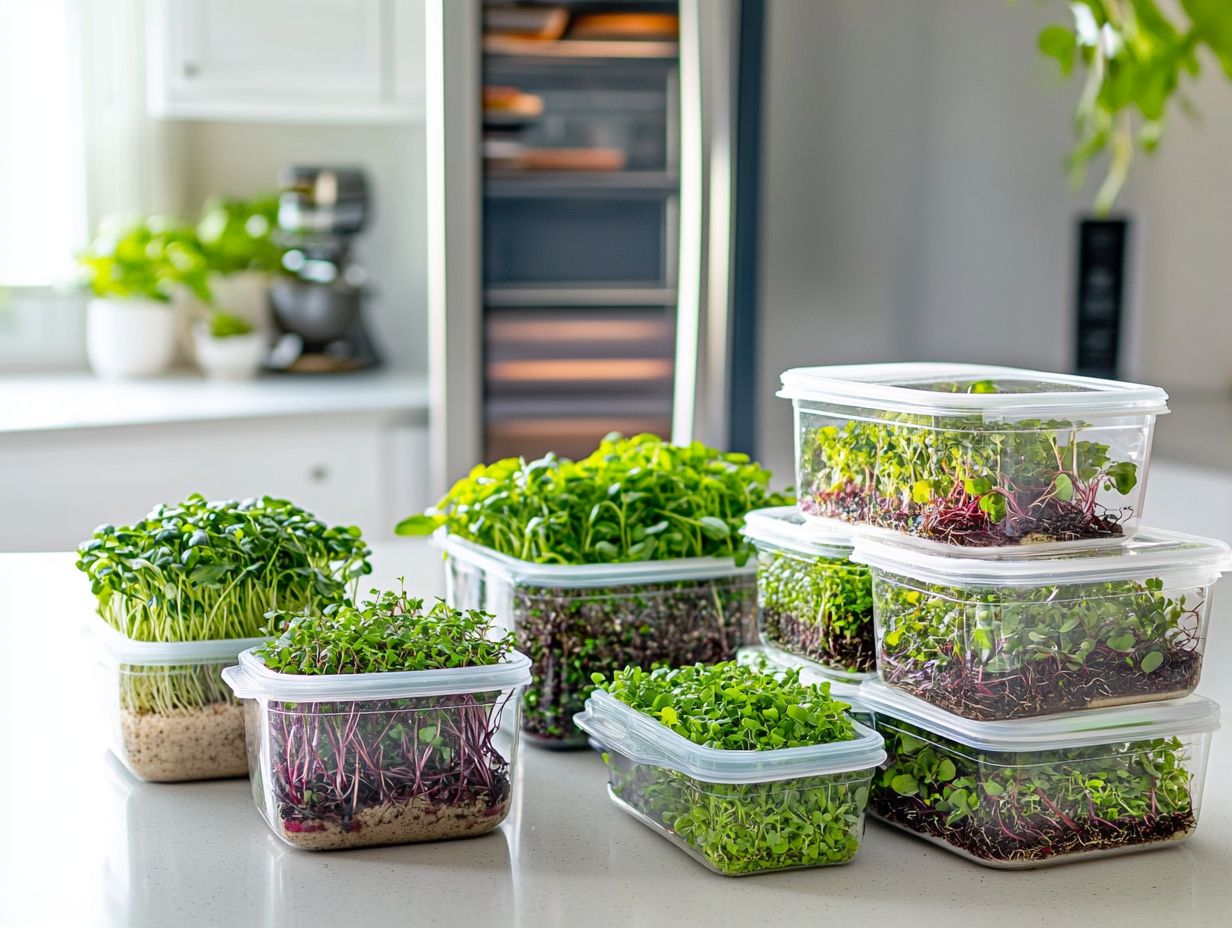
Proper microgreen storage techniques are crucial for business success, as maintaining freshness and quality directly impacts customer satisfaction and retention.
When businesses prioritize effective storage practices, they not only extend the shelf life of their products but also enhance their overall flavor retention and nutritional value. For example, a local juice bar that meticulously manages its inventory with temperature-controlled storage has seen significant reductions in spoilage rates and an influx of customer feedback praising the quality of their juice blends made with fresh microgreens.
Similarly, an organic salad restaurant employing vacuum-sealing techniques a method to remove air from packaging has experienced a notable increase in repeat customers who appreciate consistently fresh flavors.
These practices can skyrocket your brand s reputation and cultivate lasting customer loyalty, highlighting the importance of effective storage techniques in the microgreens industry.
Frequently Asked Questions
Explore our resources to learn how to engage with your microgreens creatively and maximize their potential in your kitchen!
What are the five key factors for successful microgreen storage?
The five key factors for successful microgreen storage are temperature, humidity, air circulation, cleanliness, and proper packaging. These elements are vital for keeping microgreens fresh and delicious.
How does temperature affect microgreen storage?
Temperature is key to slowing spoilage. Store your microgreens between 35-40 F for the best results.
Why is humidity important for microgreen storage?
Humidity keeps microgreens moist and prevents them from drying out. Aim for humidity levels between 95-100% in storage.
How does air circulation impact microgreen storage?
Good air circulation stops moisture buildup, reducing the chances of mold and bacteria. You can use a fan or ventilation to keep the air moving.
Why is cleanliness crucial for successful microgreen storage?
A clean storage area prevents contamination. Regularly clean and sanitize all containers and surfaces to keep your microgreens safe.
What is the importance of proper packaging for microgreen storage?
Proper packaging keeps microgreens fresh by shielding them from light, moisture, and air. Use airtight containers to extend their shelf life and preserve flavor.

